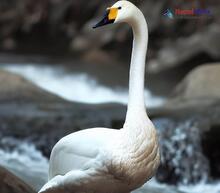The Cygnus genus, commonly known as swans, are gracefully elegant creatures that captivate wildlife enthusiasts and scientists alike with their beauty and mystique. While these birds have a remarkable presence globally, understanding their evolution tree, taxonomy, morphology, ecology, and role within the environment of Nepal is fundamental to appreciating their importance in the broader ecosystem. Let us look at the various aspects of this genus:
Diving into the Evolution Tree and Taxonomy
As part of the Anatidae family, the Cygnus genus belongs to the Aves class within the Chordata phylum. Within the Cygnus genus are six species of swans that display a range of fascinating attributes. The evolution tree for these birds traces back millions of years, illustrating a rich tapestry of speciation events that have contributed to the biodiversity exhibited among swans today.
Morphological Beauty Unravelled
Swans possess several morphological characteristics that make them unique among waterfowl. Known for their elongated necks and grand wingspans, adult swans typically exhibit white plumage while juvenile swans may don gray or brownish feathers before attaining full maturity. Males (cobs) are generally larger than females (pens), with both genders sharing large webbed feet adapted for swimming and convex bills equipped for foraging and self-defense.
Ecology: An Essential Element of Aquatic Ecosystems
Swans are unparalleled contributors to aquatic ecosystems around the world due to their diverse array of ecological roles. By consuming underwater vegetation and dabbling in shallow waters, swans aid in nutrient cycling within lakes and ponds. Furthermore, as migratory birds with expansive range distributions, they contribute to gene flow across vast geographic distances.
The Emblematic Status of Swans in Nepal
Nepal's rich biodiversity supports a variety of avian species, including the swans. The incorporation of these magnificent birds into regional ecosystems can contribute significantly to aquatic environments, and efforts should be made to raise awareness of their conservation needs in Nepal.
In conclusion, the Cygnus genus is a captivating facet of ornithological research. Gaining a deeper understanding of swans' evolution, taxonomy, morphology, and ecology enables us to appreciate their vital role in global ecosystems, including Nepal. Whether admired for their elegance or studied for scientific interest, the intrigue surrounding these majestic creatures captivates audiences across generations.




